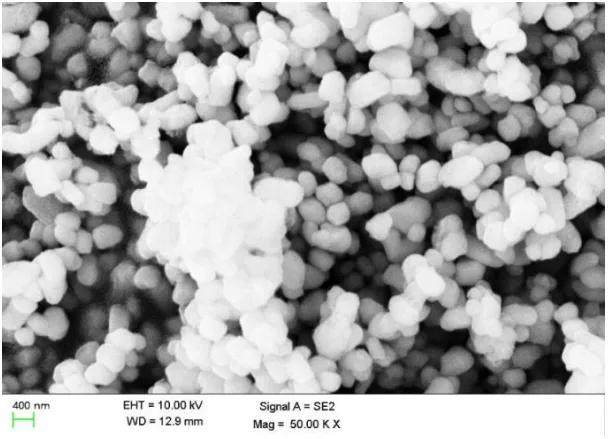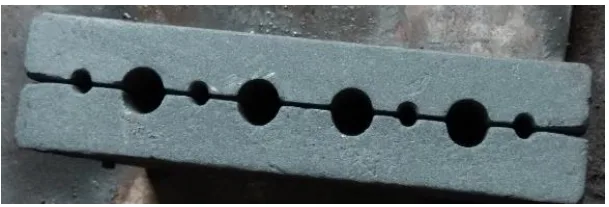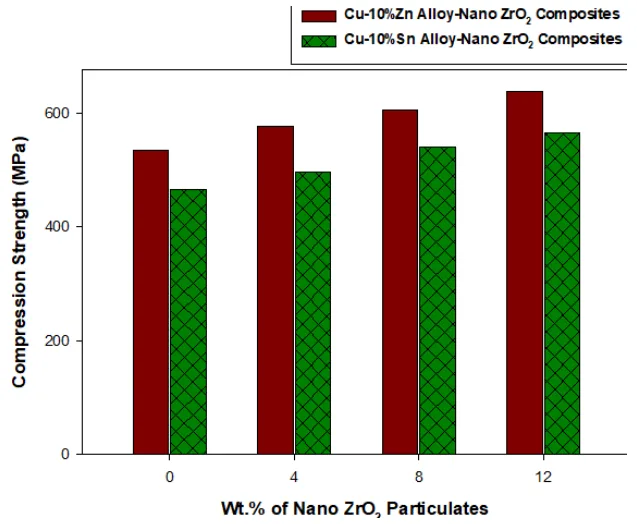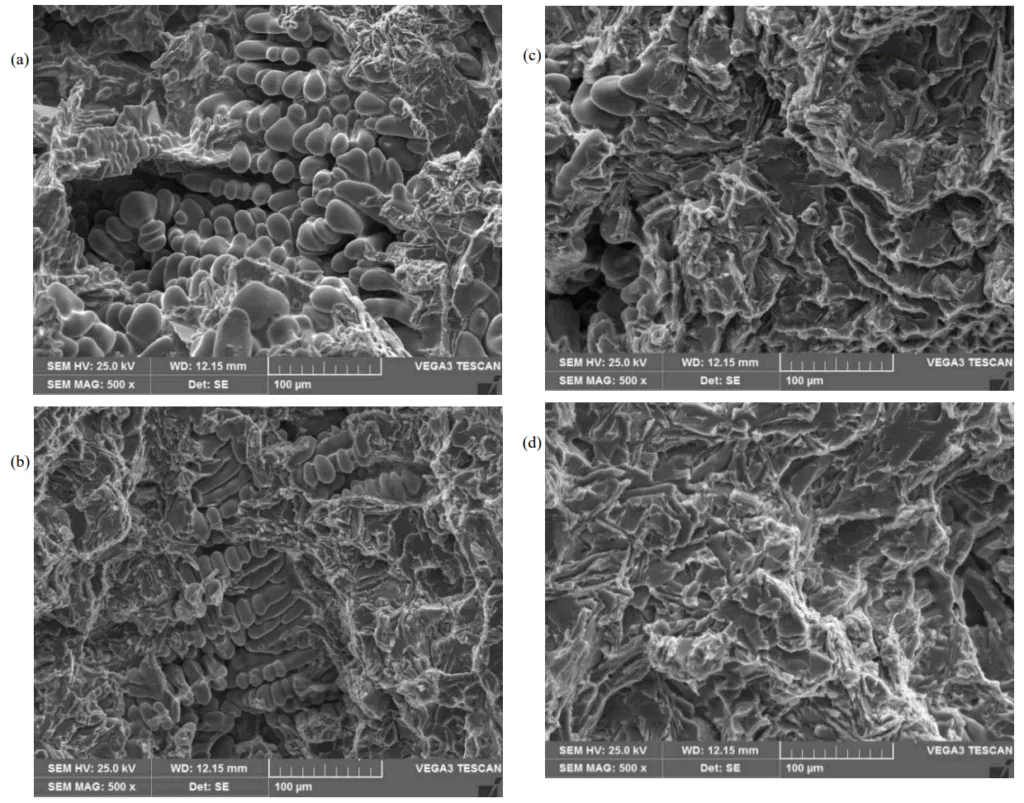Boosting Copper-Tin Alloy Performance: How Nano ZrO2 Reinforcement Unlocks Superior Mechanical Strength
This technical summary is based on the academic paper "EFFECT OF NANO ZIRCONIUM OXIDE (ZrO2) PARTICLES ADDITION ON THE MECHANICAL BEHAVIOUR AND TENSILE FRACTOGRAPHY OF COPPER-TIN (Cu-Sn) ALLOY NANO COMPOSITES" by Prasad H. Nayak et al., published in Structural Integrity and Life (2022).


Keywords
- Primary Keyword: Copper-Tin Alloy Composites
- Secondary Keywords: Nano ZrO2, Mechanical Properties, Stir Casting, Tensile Strength, Hardness, Fractography, Metal Matrix Composites
Executive Summary
- The Challenge: Standard Copper-Tin (Cu-Sn) alloys, while useful, possess inherent limitations in hardness and strength that restrict their use in high-performance engineering applications.
- The Method: Researchers fabricated advanced Cu-10%Sn nano-composites by reinforcing the alloy with 4, 8, and 12 weight percent (wt.%) of nano-sized Zirconium Oxide (ZrO2) particles using a liquid metallurgy stir casting technique.
- The Key Breakthrough: The addition of nano ZrO2 particles resulted in a significant and progressive increase in the material's hardness, yield strength, and ultimate tensile strength as the reinforcement content increased to 12 wt.%.
- The Bottom Line: Reinforcing Cu-Sn alloys with nano ZrO2 is a proven and effective method for creating advanced metal matrix composites with enhanced mechanical properties tailored for demanding industrial components.
The Challenge: Why This Research Matters for HPDC Professionals
In the world of engineering materials, the demand for components with greater strength, higher stiffness, and superior wear resistance is relentless. While metal alloys like copper-tin (bronze) are valued for their conductivity and corrosion resistance, they often fall short when faced with extreme mechanical stress. The industry has long sought cost-effective ways to enhance these foundational materials rather than resorting to more exotic and expensive alternatives. This research directly addresses this challenge by exploring how the strategic addition of ceramic nano-particles can elevate the performance of a conventional Cu-Sn alloy, transforming it into a high-strength composite material suitable for applications in the automotive, aerospace, and biomedical fields.
The Approach: Unpacking the Methodology
The research team employed a robust and scalable liquid metallurgy technique to create the nano-composites. This section provides confidence that the results are based on a sound and repeatable manufacturing process.
Method 1: Composite Fabrication via Stir Casting
The core of the methodology was the stir casting process. Pre-weighed ingots of Cu-10%Sn alloy were melted in an electric furnace and heated to 1150 °C. To ensure a homogenous mixture, a vortex was created in the molten metal using a stirrer rotating at 300 rpm. Nano-sized ZrO2 particles, preheated to 500 °C to improve wettability and distribution, were then gradually introduced into this vortex at concentrations of 4, 8, and 12 wt.%. The resulting composite slurry was then poured into cast iron molds to solidify.
Method 2: Material Characterization and Mechanical Testing
To validate the material's structure and performance, a comprehensive suite of tests was conducted according to ASTM standards:
- Microstructural Analysis: Scanning Electron Microscopy (SEM), Energy-Dispersive X-ray Spectroscopy (EDS), and X-ray Diffraction (XRD) were used to confirm the uniform distribution of ZrO2 particles and identify the elemental and phase compositions of the final composites.
- Mechanical Property Evaluation: Hardness was measured using a Brinell hardness tester (ASTM E10). Tensile properties, including Ultimate Tensile Strength (UTS), Yield Strength (YS), and percentage elongation, were determined using an Instron servo-hydraulic machine (ASTM E8).
The Breakthrough: Key Findings & Data
The study yielded clear, data-driven evidence of significant performance improvements in the reinforced alloys.
Finding 1: Substantial Gains in Hardness and Strength
The addition of hard nano ZrO2 particles acted as a powerful reinforcement within the softer Cu-Sn alloy matrix. This led to a direct and substantial increase in key mechanical properties. As shown in Figure 9, the hardness of the base alloy was 69.1 BHN. This value systematically increased to 75.4 BHN, 82.9 BHN, and a peak of 90.8 BHN for composites with 4, 8, and 12 wt.% ZrO2, respectively. Similarly, the Ultimate Tensile Strength (Figure 11) rose from 272.4 MPa in the base alloy to 341.6 MPa in the 12 wt.% composite—a 25.4% improvement. The Yield Strength (Figure 13) also saw a significant boost, climbing from 221.1 MPa to 283.3 MPa.
Finding 2: Uniform Particle Distribution with a Trade-off in Ductility
The SEM micrographs presented in Figure 5b-d confirmed that the stir casting method was highly effective, achieving a uniform distribution of nano ZrO2 particles throughout the alloy matrix with no voids or defects. This homogeneity is crucial for consistent and reliable material performance. However, this enhancement in strength came with a predictable trade-off in ductility. As detailed in Figure 14, the percentage elongation of the base alloy was 14.9%. This value decreased as more reinforcement was added, reaching 12.2% for the 12 wt.% ZrO2 composite. This occurs because the hard ceramic particles impede the plastic flow of the metal matrix, making the material stronger but less deformable.
Practical Implications for R&D and Operations
- For Process Engineers: This study validates stir casting as an effective method for producing nano-particle reinforced composites. It suggests that controlling key parameters like stirring speed (300 rpm), melt temperature (1150 °C), and preheating the reinforcement particles (500 °C) is critical to achieving uniform particle dispersion and avoiding defects.
- For Quality Control Teams: The data in Figure 9 establishes a clear correlation between ZrO2 content and Brinell hardness. This provides a straightforward and non-destructive metric for verifying the composition and quality of manufactured components. Furthermore, the fractography analysis in Figure 17 illustrates the shift from ductile to more brittle fracture modes, offering a valuable tool for failure analysis.
- For Design Engineers: The findings demonstrate that Cu-Sn alloy composites can be engineered with significantly higher strength and hardness. This allows for the design of more robust, wear-resistant components or the reduction of component weight without sacrificing performance. However, the corresponding decrease in elongation (ductility) must be factored into designs for applications that require high toughness or are subject to impact loading.
Paper Details
EFFECT OF NANO ZIRCONIUM OXIDE (ZrO2) PARTICLES ADDITION ON THE MECHANICAL BEHAVIOUR AND TENSILE FRACTOGRAPHY OF COPPER-TIN (Cu-Sn) ALLOY NANO COMPOSITES
1. Overview:
- Title: EFFECT OF NANO ZIRCONIUM OXIDE (ZrO2) PARTICLES ADDITION ON THE MECHANICAL BEHAVIOUR AND TENSILE FRACTOGRAPHY OF COPPER-TIN (Cu-Sn) ALLOY NANO COMPOSITES
- Author: Prasad H. Nayak, H.K. Srinivas, P. Rajendra, Madeva Nagaral, M. Raviprakash, V. Auradi
- Year of publication: 2022
- Journal/academic society of publication: STRUCTURAL INTEGRITY AND LIFE (Vol. 22, No 3 (2022), pp. 319-327)
- Keywords: Cu-Sn alloy, ZrO2 nano particles, stir process, hardness, tensile properties, fractography
2. Abstract:
In the current investigation, an exertion is prepared to produce copper-10%tin-nano ZrO2 composites by exploiting melt technique. 4, 8, and 12 wt.% of nano ZrO2 particles are introduced to the copper-tin (Cu-Sn) base network. Micro-structural studies are performed by SEM, EDS, and XRD examination. Mechanical portrayal of Cu-10%Sn-4, 8, 12 wt. % of nano ZrO2 composites are measured conferring to ASTM norms. Scanning electron micrographs uncovered the uniform conveyance of nano ZrO2 in the copper-tin amalgam framework. EDX investigation affirmed the presence of Zr and O in nano-ZrO2 built-up composites, and XRD designs uncovered the Cu, Sn, and ZrO2 phases. It is further noticed that hardness, yield strength of Cu-Sn compound increased with the content of 4, 8, and 12 wt.% of nano-ZrO2. Elongation of nano composites diminishes by adding oxide particles. Fractography of tensile examples is completed by utilising SEM micrographs to comprehend the failure of components.
3. Introduction:
Metal matrix composites (MMCs) are a class of materials offering unique property combinations for various engineering applications, including automotive, aerospace, and biomedical components. MMCs provide tailor-made properties such as greater strength, higher stiffness, and superior resistance to corrosion and wear. Copper is a widely utilized metal due to its high conductivity and corrosion resistance, but its lower mechanical properties necessitate reinforcement. Zirconium oxide (ZrO2) is a superior reinforcement material due to its high hardness, strength, good impact and wear resistance, and chemical stability. This study investigates the synthesis of copper alloy composites with ZrO2 reinforcement using a liquid melt technique.
4. Summary of the study:
Background of the research topic:
The study is situated within the field of metal matrix composites (MMCs), specifically focusing on the enhancement of copper-based alloys. Copper and its alloys are essential materials for applications like bearings, but their mechanical properties can be a limiting factor. Reinforcing these alloys with hard ceramic particles like Zirconium Oxide (ZrO2) is a recognized strategy to improve performance characteristics such as hardness and strength.
Status of previous research:
The authors note that while MMCs are widely studied, previous investigations reveal that only a very few studies have been made on the use of ZrO2 as reinforcement to synthesize copper alloy composites by liquid melt technique. This identifies a gap in the existing literature that the current study aims to address.
Purpose of the study:
The primary objective of this investigation is to produce and characterize copper-10%tin-nano ZrO2 composites. The study aims to systematically evaluate the effect of adding varying weight percentages (4, 8, and 12 wt.%) of nano ZrO2 particles on the microstructural characteristics, mechanical properties (hardness, tensile, compressive), and tensile fracture behavior of the Cu-Sn alloy.
Core study:
The core of the study involves the fabrication of Cu-10%Sn-xZrO2 (where x = 0, 4, 8, 12 wt.%) composites using a stir casting method. The fabricated composites were then subjected to extensive characterization. Microstructural analysis was performed using SEM, EDS, and XRD. Mechanical properties were evaluated according to ASTM standards, including Brinell hardness, ultimate tensile strength, yield strength, percentage elongation, and compressive strength. Finally, fractography was performed on the tensile fracture surfaces to understand the failure mechanisms.
5. Research Methodology
Research Design:
The study employed an experimental research design. A base alloy (Cu-10%Sn) and three composite compositions with varying levels of nano ZrO2 reinforcement (4, 8, and 12 wt.%) were fabricated under controlled conditions. The properties of the composites were then measured and compared against the unreinforced base alloy to determine the effect of the reinforcement.
Data Collection and Analysis Methods:
- Fabrication: Composites were fabricated using a liquid metallurgy stir casting process. The Cu-Sn alloy was melted and mechanically stirred to form a vortex, into which preheated nano ZrO2 particles were introduced. The mixture was then cast into molds.
- Microstructural Analysis: Samples were examined using a Scanning Electron Microscope (SEM) to observe particle distribution. Energy-Dispersive X-ray Spectroscopy (EDS) was used for elemental analysis, and X-ray Diffraction (XRD) was used for phase identification.
- Mechanical Testing: Hardness was measured using the Brinell method (ASTM E10). Tensile tests were conducted on prepared specimens as per ASTM E8 to determine UTS, YS, and elongation. Compression tests were performed according to ASTM E9.
Research Topics and Scope:
The research is focused on the fabrication and characterization of a copper-tin (Cu-10%Sn) alloy reinforced with nano-sized Zirconium Oxide (ZrO2) particles. The scope is limited to three reinforcement levels: 4, 8, and 12 weight percent. The investigation covers the microstructural, mechanical (hardness, tensile, compressive), and fractographic properties of these specific composites.
6. Key Results:
Key Results:
- SEM micrographs revealed a uniform distribution of nano ZrO2 reinforcement particles throughout the Cu10%Sn matrix, with good interfacial bonding and no significant casting defects.
- EDS analysis confirmed the presence of Zr and O elements in the reinforced composites, and XRD patterns identified the distinct phases of Cu, Sn, and ZrO2.
- The hardness of the composites increased progressively with the addition of ZrO2, from 69.1 BHN for the base alloy to 90.8 BHN for the composite with 12 wt.% ZrO2.
- Ultimate Tensile Strength (UTS) and Yield Strength (YS) both increased significantly with higher ZrO2 content. UTS improved from 272.4 MPa to 341.6 MPa, and YS from 221.1 MPa to 283.3 MPa for the 12 wt.% composite.
- The percentage elongation decreased as the reinforcement content increased, from 14.9% for the base alloy to 12.2% for the 12 wt.% composite, indicating a reduction in ductility.
- Fractography of tensile specimens showed that the failure mechanism transitioned from a ductile, dimpled fracture in the base alloy to a more brittle fracture mode in the composites with higher concentrations of ZrO2.
Figure Name List:


- Figure 1. SEM micrograph of nano ZrO2 particles.
- Figure 2. Cast iron die.
- Figure 3. Tensile test specimen.
- Figure 4. Compression test specimen.
- Figure 5. SEMs of: a) Cu10%Sn alloy; b) Cu10%Sn-4% ZrO2; c) Cu10%Sn-8% ZrO2; d) Cu10%Sn-12% ZrO2 composites.
- Figure 6. EDSs of: a) Cu10%Sn alloy; b) Cu10%Sn with 4% ZrO2; c) Cu10%Sn with 8% ZrO2; d) Cu10%Sn with 12% ZrO2.
- Figure 7. XRD patterns of: a) as-cast Cu10%Sn alloy; b) Cu10%Sn with 4% ZrO2; c) Cu10%Sn with 8% ZrO2; d) Cu10%Sn with 12% ZrO2 composites.
- Figure 8. Theoretical and experimental densities of Cu10 wt.% Sn alloy with nano ZrO2 reinforced composites.
- Figure 9. Hardness of Cu10 wt.% Sn alloy with nano ZrO2 composites.
- Figure 10. Theoretical and experimental hardness of Cu10 wt.% Sn alloy with nano ZrO2 reinforced composites.
- Figure 11. UTS of Cu10 wt.% Sn alloy with nano ZrO2 composites.
- Figure 12. Theoretical and experimental UTS of Cu10 wt.% Sn alloy with nano ZrO2 reinforced composites.
- Figure 13. YS of Cu10 wt.% Sn alloy with nano ZrO2 composites.
- Figure 14. Percentage elongation of Cu10 wt.% Sn alloy with nano ZrO2 composites.
- Figure 15. Compressive strength of Cu10 wt.% Sn alloy with nano ZrO2 composites.
- Figure 16. Compressive strength comparison for Cu10 wt.% Zn and Cu10 wt.% Sn alloys with nano ZrO2 reinforced composite.
- Figure 17. SEMs of tensile fractured surfaces: a) CuSn alloy; b) CuSn-4 wt.% ZrO2; c) CuSn-8 wt.% ZrO2; d) CuSn-12 wt.% ZrO2 composites.
7. Conclusion:
The copper-tin alloy with 4 to 12 wt.% of nano ZrO2 particulate composites has been successfully fabricated by stir casting route. The SEM microphotos reveal an even dissemination of nano ZrO2 particles in the Cu10 wt.% Sn alloy composites. EDS and XRD analysis reveal the presence of nano ZrO2 particles in Cu10 wt.% Sn alloy composites in the form of Zr and O elements. Theoretical and experimental densities of CuSn with ZrO2 composites decrease as the wt. % of reinforcement increases from 4 to 12 wt.%. The hardness, tensile, and compressive strengths of Cu10 wt.% Sn alloy with 4 to 12 wt.% of ZrO2 composites increases with the addition of ZrO2 particles. Percentage elongation of the CuSn alloys decreases with the addition of nano ZrO2 particles. It decreases further as the wt.% of the reinforcement increases from 4 to 12 wt.%. Fractography analysis indicates various fracture mechanisms in CuSn alloy matrices with 4 to 12 wt.% of nano ZrO2 composites.
8. References:
- Nagaral, M., Kalgudi, S., Auradi, V., Kori, S.A. (2018), Mechanical characterization of ceramic nano B4C- Al2618 alloy composites synthesized by semi solid state processing, Trans. Indian Cer. Soc. 77(3): 146-149. doi: 10.1080/0371750X.2018.1506363
- Nagaral, M., Shivananda, B.K., Auradi, V., et al. (2017), Mechanical behavior of Al6061-Al2O3 and Al6061-graphite composites, Mater. Today: Proc. 4(10): 10978-10986. doi: 10.1016/j.matpr.2017.08.055
- Jadhav, P., Sridhar, B.R., Nagaral, M., et al. (2018), A comparative study on microstructure and mechanical properties of A356-B4C and A356-graphite composites, Int. J Mech. Prod. Eng. Res. Devel. 8(2): 273-282.
- Nagaral, M., Auradi, V., Kori, S.A., Hiremath, V. (2019), Investigations on mechanical and wear behavior of nano Al2O3 particulates reinforced AA7475 alloy composites, J Mech. Eng. Sci. 13(1): 4623-4635. doi: 10.15282/jmes.13.1.2019.19.0389
- Harti, J.I., Prasad, T.B., Nagaral, M., et al. (2017), Microstructure and dry sliding wear behaviour of Al2219-TiC composites, Mater. Today: Proc. 4(10): 11004-11009. doi: 10.1016/j.matpr.2017.08.058
- Mazahery, A., Ostad Shabani, M. (2013), Microstructural and abrasive wear properties of SiC reinforced aluminum-based composite produced by compocasting, Trans. Nonferr. Met. Soc. China, 23(7): 1905-1914. doi: 10.1016/S1003-6326(13)62676-X
- Nayak, P.H., Srinivas, H.K., Nagaral, M., Auradi, V. (2019), Characterization and tensile fractography of nano ZrO2 reinforced copper-zinc alloy composites, Frattura ed Integ. Strutturale, 13 (48): 370-376. doi: 10.3221/IGF-ESIS.48.35
- Nagaral, M., Hiremath, V., Auradi, V., Kori, S.A. (2018), Influence of two-stage stir casting process on mechanical characterization and wear behavior of AA2014-ZrO2 nano-composites, Trans. Ind. Inst. Met. 71: 2845-2850. doi: 10.1007/s12666-018-1441-6
- Kumar, L., Nasimul Alam, S., Kumar Sahoo, S., Teja, M.B.K. (2018), Mechanical properties of Cu-MWCNT composites developed by powder metallurgy route, Mater. Today: Proc. 5(9): 19883-19892. doi: 10.1016/j.matpr.2018.06.353
- Nagaral, M., Shivananda, B.K., Jayachandran, et al. (2016), Effect of SiC and graphite particulates addition on wear behaviour of Al2219 alloy hybrid composites, IOP Conf. Ser.: Mater. Sci. Eng. 149: 012108. doi: 10.1088/1757-899X/149/1/012108
- Bharath, V., Nagaral, M., Auradi, V., Kori, S.A. (2014), Studies on dry sliding wear characteristics of ceramic Al2O3 particulate reinforced 6061Al matrix composites, Adv. Mater. Res. 984-985: 319-325. doi: 10.4028/www.scientific.net/AMR.984-985.319
- Mallikarjuna, H.M., Kashyap, K.T., Koppad, P.G., et al. (2016), Microstructure and dry sliding wear behavior of Cu-Sn alloy reinforced with multiwalled carbon nanotubes, Trans. Nonferr. Met. Soc. China, 26(7): 1755-1764. doi: 10.1016/S1003-6326 (16)64269-3
- Ezatpour, H.R., Torabi-Parizi, M., Sajjadi, S.A. (2013), Microstructure and mechanical properties of extruded Al/Al2O3 composites fabricated by stir-casting process, Trans. Nonferr. Met. Soc. China, 23(5): 1262-1268. doi: 10.1016/S1003-6326(13)62 591-1
- Fazil, N., Venkataraman, V., Nagaral, M. (2020), Mechanical characterization and wear behavior of aerospace alloy AA2124 and micro B4C reinforced metal composites, J Met., Mater. Miner. 30(4): 97-105. doi: 10.14456/jmmm.2020.57
- Shashidhar, S., Kumar, P.V., Shivanand, H.K., Nagaral, M. (2018), Processing, microstructure, density and compression behaviour of nano B4C particulates reinforced Al2219 alloy composites, Int. J Adv. Technol. Eng. Expl. 5(46): 350-355. doi: 10 .19101/IJATEE.2018.546015
- Prasad, G.P., Chittappa, H.C., Nagaral, M., Auradi, V. (2020), Influence of B4C reinforcement particles with varying sizes on the tensile failure and fractography of LM29 alloy composites, J Fail. Anal. Prev. 20(6): 2078-2086. doi: 10.1007/s11668-020-01021-6
- Bharath, V., Ashita, D.H., Auradi, V., Nagaral, M. (2020), Influence of variable particle size reinforcement on mechanical and wear properties of alumina reinforced 2014Al alloy particulate composite, FME Trans. 48(4): 968-978. doi: 10.5937/fme2004 968B
- Bharath, V., Auradi, V., Nagaral, M., Bopanna, S.B. (2020), Experimental investigations on mechanical and wear behaviour of 2014Al-Al2O3 composites, J Bio Tribo Corros. 6: 45. doi: 10. 1007/s40735-020-00341-2
- Harti, J.I., Prasad, T.B., Nagaral, M., et al. (2021), Microstructure, mechanical behavior and tensile fractography of 90-micron-sized titanium carbide particles reinforced Al2219 alloy die cast metal composites, J Fail. Anal. Preven. 21: 631-639. doi: 10.10 07/s11668-020-01107-1
- Kumar, R., Deshpande, R.G., Gopinath, B., et al. (2021), Mechanical fractography and worn surface analysis of nanographite and ZrO2-reinforced Al7075 alloy aerospace metal composites, J Fail. Anal. Preven. 21: 525-536. doi: 10.1007/s11668-020-01 092-5
Expert Q&A: Your Top Questions Answered
Q1: Why was the stir casting method chosen for this study instead of a method like powder metallurgy?
A1: The paper positions stir casting as a liquid metallurgy technique that is one of the most consistent methods for strengthening copper-based composites. This method is generally considered cost-effective, scalable for bulk production, and well-suited for achieving a uniform distribution of reinforcement particles in a metallic matrix, as demonstrated by the SEM results in the study.
Q2: What is the significance of using nano-sized ZrO2 particles as opposed to micro-sized particles?
A2: While the paper does not explicitly compare nano vs. micro particles, the use of nano-sized reinforcements is a key aspect of the study. Nano-particles offer a much higher surface-area-to-volume ratio, which allows for more effective load transfer from the matrix to the reinforcement. This leads to more efficient strengthening by impeding dislocation motion, resulting in the significant gains in hardness and strength observed even at relatively low weight percentages.
Q3: The study shows that the density of the composite decreases with more ZrO2. What is the practical benefit of this?
A3: The density of the Cu-Sn alloy is 8.76 g/cm³, while the density of ZrO2 is significantly lower at 5.68 g/cm³. As shown in Figure 8, adding ZrO2 progressively lowers the overall density of the composite. This means the resulting material is not only stronger and harder but also lighter, leading to a higher strength-to-weight ratio. This is a highly desirable characteristic for applications in the aerospace and automotive industries, where weight reduction is critical.
Q4: How was a uniform distribution of the nano-particles achieved in the molten metal, which is often a challenge?
A4: The methodology details a multi-step approach to ensure uniform distribution. First, a strong vortex was created in the liquid metal by stirring at 300 rpm. Second, the nano ZrO2 particles were preheated to 500 °C. This preheating step is crucial as it helps burn off any absorbed moisture and improves the wettability of the ceramic particles by the molten metal, allowing them to be incorporated more easily and preventing them from clumping together.
Q5: The fractography (Figure 17) shows a shift in the failure mechanism. What does this imply for component reliability in real-world applications?
A5: The base alloy exhibits a classic ductile fracture, characterized by dimples, which indicates the material can absorb significant energy before failing. As ZrO2 content increases, the fracture surface becomes less dimpled, indicating a shift towards a more brittle failure mode. This means that while the composite is much stronger, it has lower toughness and may be more susceptible to sudden failure under impact or shock loading. Engineers must consider this trade-off between strength and toughness when designing components.
Q6: What did the XRD analysis (Figure 7) confirm about the final material?
A6: The XRD patterns were essential for verifying the composition of the final material at a phase level. The results showed distinct peaks corresponding to Cu, Sn, and ZrO2. This confirms that the ZrO2 particles were successfully incorporated into the alloy matrix and remained as a distinct reinforcing phase, without reacting with the copper or tin to form unintended or detrimental intermetallic compounds during the casting process.
Conclusion: Paving the Way for Higher Quality and Productivity
This research provides compelling evidence that the mechanical limitations of conventional bronze can be overcome through advanced material engineering. By reinforcing a standard Cu-Sn alloy with nano ZrO2 particles, it is possible to create high-performance Copper-Tin Alloy Composites with significantly improved hardness and strength. The study validates stir casting as a viable and effective manufacturing route, offering a clear pathway for producing these advanced materials at an industrial scale. The key takeaway for R&D and operations teams is that a well-controlled process can yield a superior material with a predictable set of enhanced properties, opening the door for more durable and lightweight components.
At CASTMAN, we are committed to applying the latest industry research to help our customers achieve higher productivity and quality. If the challenges discussed in this paper align with your operational goals, contact our engineering team to explore how these principles can be implemented in your components.
Copyright Information
This content is a summary and analysis based on the paper "EFFECT OF NANO ZIRCONIUM OXIDE (ZrO2) PARTICLES ADDITION ON THE MECHANICAL BEHAVIOUR AND TENSILE FRACTOGRAPHY OF COPPER-TIN (Cu-Sn) ALLOY NANO COMPOSITES" by "Prasad H. Nayak, H.K. Srinivas, P. Rajendra, Madeva Nagaral, M. Raviprakash, V. Auradi".
Source: This work is based on the paper published in STRUCTURAL INTEGRITY AND LIFE, Vol. 22, No 3 (2022), pp. 319-327.
This material is for informational purposes only. Unauthorized commercial use is prohibited.
Copyright © 2025 CASTMAN. All rights reserved.